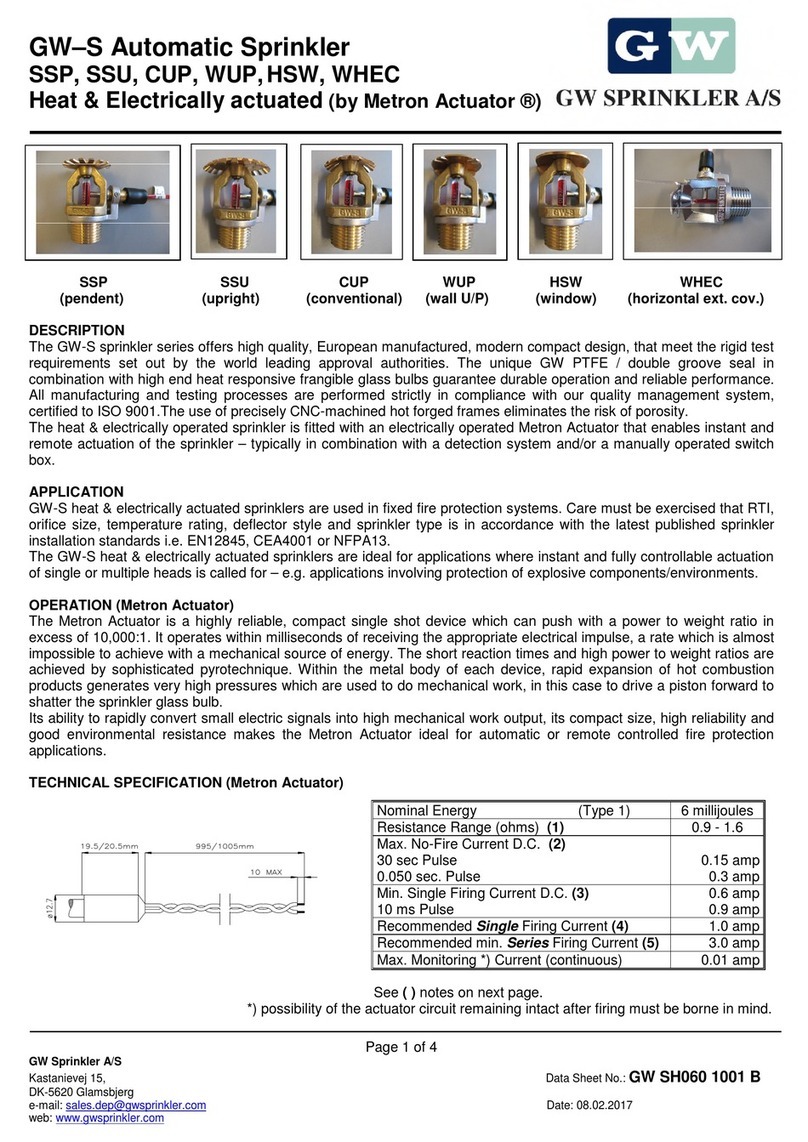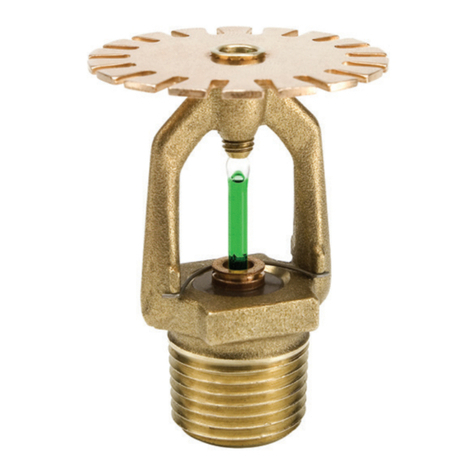
GW Manual No. 846
M5 / Local Application Fire Protection of Category A Engine Rooms– IMO / MSC.1/Circ. 1387
Dated: 04-06-2014
installed in such a way that the activation of a nozzle zone does not affect the performances of the
applications in the engine rooms. It should be possible to activate local application systems without having to
evacuate persons from the space.
A Local Application Fire Protection System limits the damages, it cools and it allows additional manual fire
fighting to take place, and hereby provides time to activate the main fire fighting system of the engine room if
that should become necessary.
Local application fire protection systems are only for indoor fire fighting. Strong draft in the protected area
should be avoided/prevented, when systems are activated.
1.7 Low water pressures. Low water flows. Wide installation heights. Low electric power
requirements.
The GW Model M5 Water Mist Nozzle has a hydraulic k-value of 5 (l/min \bar). The GW Model M5 Local
Application Fire Protection System controls fires with low-pressure water mist system. 90% of the water
sprayed from the GW Model M5 nozzles is distributed in water droplets, which are smaller than 250 µm in
diameter. The system has passed the IMO MSC.1/Circ.913 (acceptable to MSC.1/Circ 1387) fire test
requirements with an array of only four nozzles.
This allows, in accordance with MSC.1/Circ. 1387, applications to be locally fire protected with GW Model M5
nozzles installed only above the periphery and within the foot print of the protected area. Attention should be
made to obstructions between the nozzles and the application surfaces (chapter 2.3).
The power required for a water mist system (E) is a function the efficiency factor () times the water pressure
(P) times the water flow (Q): E = x P x Q
From this formula it is obvious that low-pressure (P), results in low power requirements.
Nozzle installation
heights above fire risk
(metres)
Minimum water pressure
on Nozzles
(Bar)
Maximum spacing
between pendent
installed nozzles above
applications
(Metres)
Minimum water density
on applications.
(mm/m per min)
0.5m to 8m 3.5 bar 3m 1.0
>8m to 14.5m 9 bar 3m 1.7
Table 1.1 Installation parameters for GW M5 nozzles in local application systems in accordance with
MSC.1/Circ. 1387.
The wide tolerances in installation heights makes the GW Model M5 Local Application System suitable for
installation in almost all types of engine rooms, in almost all types of ships. The high installation height allows
that nozzles are installed above hoists and other moving equipment in the engine rooms. It also allows
people to work on the applications without having to dismount the local fire fighting system.
Local Application Systems may, in accordance with MSC.1/Circ. 1387, be directly connected to the main
switchboard, or to the water supply of a main fire fighting system. The requirements to power and water
supply is that the systems are cable of supplying water for minimum 20 minutes to the application zone,
which requires the highest water flow. (For applications, installed close to each other, the requirement may
be to supply water to two applications.)
The little power requirements of the system, and the little water-flow requirements of the system sets low
requirements to the power supply, and the flow supply. GW Model M5 Local Application Systems may
therefore often be installed in ships without having to install additional power supply, or pump supplies.
1.8 Fire hazards and fuels:
GW Model M5 Local Application System has been tested in accordance with the requirements of IMO
MSC.1/Circ. 913 (acceptable to MSC.1/Circ. 1387) for the protection of local applications. The test fires in
this scenario are designed by the International Maritime Organisation. The fires are chosen to represent fires
in high-risk applications, where the dominant fire load consists of heated heavy fuel, diesel fuel and
lubrication oils under pressure.
The "hot spots" to be protected are described in SOLAS. These applications are typically: engine tops, boiler
fronts, oil separators, fuel heaters etc.





























